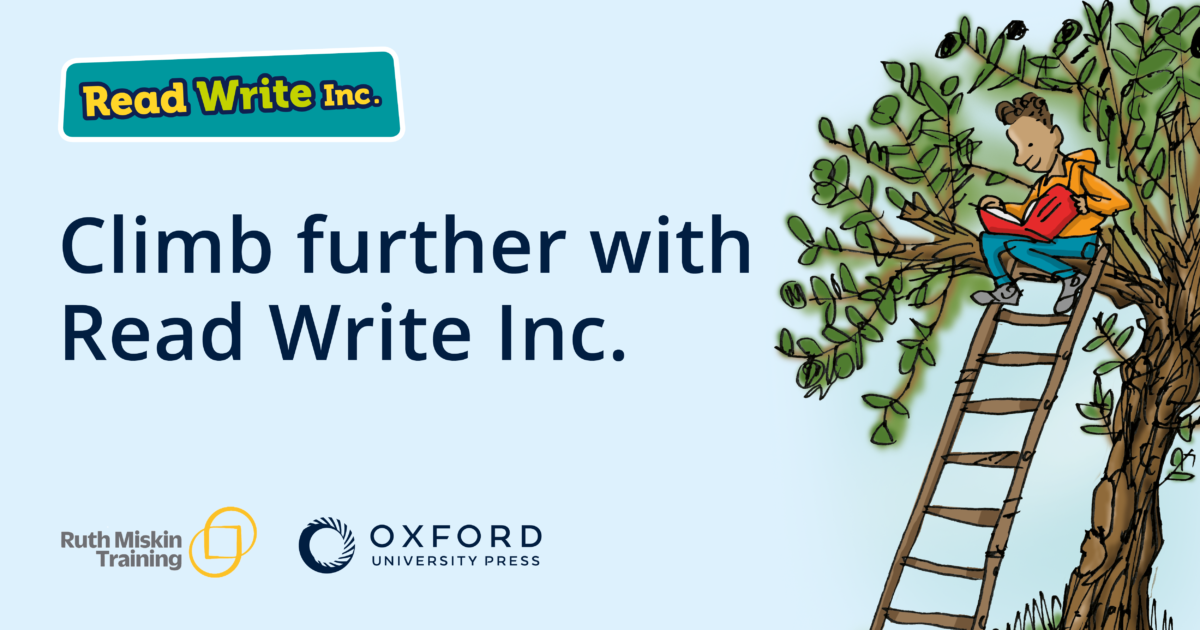Everyone talks about closing gaps – language gaps, educational gaps, knowledge gaps, cultural gaps. However, research has shown for 50 years that only readers can outrun their background. And the earlier children get on the reading ladder, the more likely they are to become readers.
With the right programme and teaching, all children can learn to read – whatever their background – including the vast majority of those with learning difficulties. Some children’s apparent learning difficulties even disappear once they can read.
Learning to read transforms children’s life chances. Not learning to read dramatically cuts down possibilities for their future.
“We haven’t let one child slip through our reading net in the 17 years we’ve been working with Ruth – that’s 16,000 children – all of whom have learnt to read.”
Shahed Ahmed OBE, CEO of New Vision Trust and Executive Head of Elmhurst Primary School
The Read Write Inc. seven steps to success
At Read Write Inc., this is what we do to help schools gain sustained long-term reading success. The ‘seven steps to success’ listed below have also helped to ensure that Read Write Inc. schools gain glowing reading deep dives by Ofsted.
Step one: Train a reading leader in your school who can support staff to become reading experts.
- Every school needs their own reading expert – a reading leader.
- If you select an experienced Key Stage 1 or Reception teacher, we’ll turn them into reading experts who can build an expert reading team through weekly coaching and practice. Every teacher will feel fully supported.
- We train teachers to teach children to read with accuracy, fluency and comprehension, and to write and spell confidently.
Step two: Get your children onto the first rung of the word reading ladder quickly, so they can begin climbing to the high fluency rungs in reception.
- We develop children’s fluency progressively. Children don’t suddenly pass through the fluency barrier! And there are no short cuts.
- We increase their accuracy and automaticity in word reading.
- We help them connect words so they sound right as they read each sentence.
- We get children to reread passages. For example, we decide how a character might be feeling, and partners experiment in what we call their ‘voice choice’.
- Through repeated readings, children learn what it feels like to be a fluent reader from the beginning.
- And for writing, we set the habits for excellent letter formation and pencil control. This is so important to get right. We teach them how to spell correctly, write sentences from dictation using to build their confidence – and we help children build their own compositions by rehearsing ideas out loud first.
Step three: Train tutors who can ensure success for children who need the most support.
- All children can learn to read. We’ve developed incremental steps necessary to make sure all children achieve success – including those who have SEND. No child is left behind.
- Our training films help tutors practise the tutoring steps, and they can see films of children making fast progress in just one ten-minute lesson.
Step four: Introduce rigorous assessment and tracking so that teachers can identify next teaching steps immediately.
- The reading leader assesses children’s phonic knowledge before they start the programme and then every half-term.
- They identify the actions that teachers need to practise so they can make the biggest difference to children’s progress.
Step five: Group children effectively so that they can make maximum progress every day.
- Direct teaching in progress groups is the quickest and most effective route to ensure all children learn to read and write. It means that every child can learn at their specific level for a full one hour every day. Reception children start with 20 minutes.
- The reading leader regroups children every half-term to maximise their progress.
- This allows teachers to provide extra practice for some and whisk others through the programme. No time is wasted. No child needs to struggle and no child is bored because it’s too easy.
Step six: Help all staff to use the best teaching strategies to gain the best learning behaviours.
- Children learn the behaviours necessary for them to cooperate during every activity.
- Partners practise everything they are taught and answer every question together.
- Children feel safe because every teacher builds upon what they say, thoughtfully and deliberately. This keeps children working and thinking throughout the lesson and gives teachers opportunities to check if something needs explaining more clearly.
Step seven: Provide extensive support for parents.
- Give parents the tools they need to support their children’s reading practice at home.
- Our virtual classroom has over 850 phonics lessons from decoding practice to supporting fluency: lessons can be sent home after it has been taught in school. This is particularly helpful if a child has missed schooling.
We’d love to help the children in your school climb to the top of the reading ladder. If you’re ready to join us, read our headteachers checklist for success first.
Ruth Miskin CBE is the creator of the UK’s leading phonics programme Read Write Inc. She is the CEO and owner of Ruth Miskin Training with more than 150 trainers working with over 8,000 schools to transform reading progress for every child.
